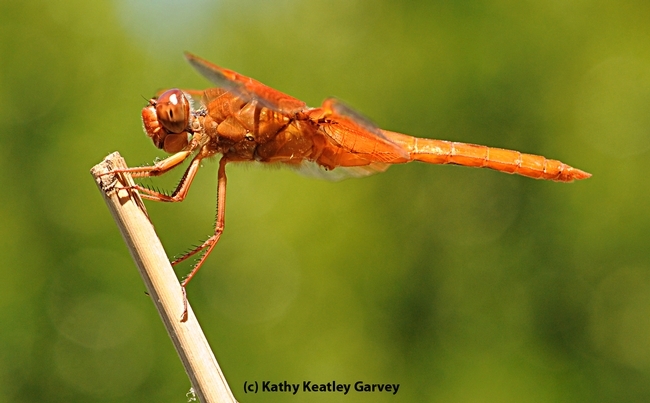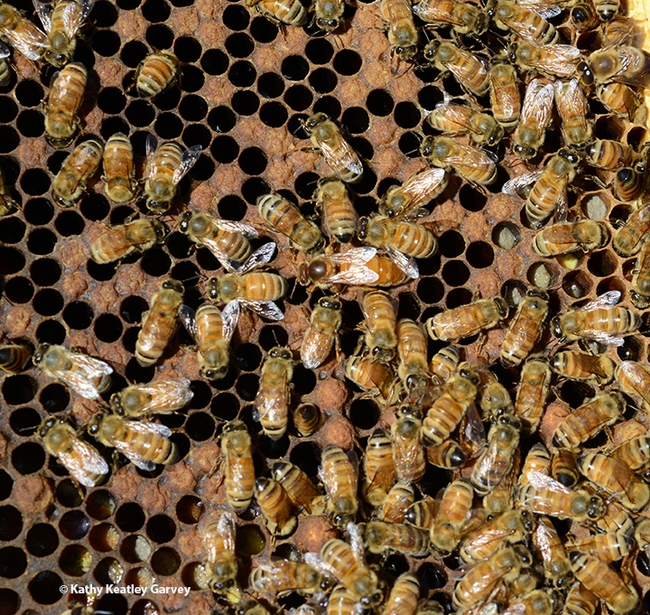- Author: Kathy Keatley Garvey

By Geoff Attardo
Assistant Professor of Entomology and Nematology at UC Davis
California's changing climate is creating a myriad of public health concerns. Wildfires, intense heatwaves, and a drought are the most readily apparent. However, increasingly temperate winters are also facilitating the spread of invasive disease-spreading mosquitoes throughout the state. Just as our fire authorities need a robust set of tools to address wildfires, it is critical that mosquito control and public health professionals have a wide range of tools to protect Californians from mosquito-borne diseases.
The growing presence of Aedes aegypti mosquitoes, which can transmit the viruses that cause Zika, dengue, chikungunya, and yellow fever as well as the parasite that causes heartworm in pets, is a major public health threat. In 2013 this invasive species was detected in the Central Valley and has been found in California every year since. These mosquitoes cohabitate with humans and often hitchhike facilitating their spread.
Aedes aegypti lay eggs in flowerpots, water storage containers or anything capable of holding small amounts of water. Part of the problem, as highlighted in our research in Frontiers in Tropical Diseases, is that these mosquitoes have cryptic breeding sites in residential areas where mosquito control agencies can't easily inspect and treat.
In addition, their eggs can dry out and then hatch when rehydrated. In fact, when Aedes aegypti were detected in 2014 in the city of Exeter there was a large eradication effort. The effort appeared successful, as they were no longer detectable in 2015. Yet, the mosquitoes were detected in Exeter again in 2018. The unique biology of this invasive species has allowed it to expand its geographical range and today they are present in more than 300 cities in California.
Another key factor is their inherent resistance to a class of insecticides called pyrethroids, which have been a mainstay for adult mosquito control because they have low toxicity to humans and other animals. Work from our lab and the California Department of Public Health found increasing insecticide resistance in these mosquitoes (Parasites and Vectors) which limits the ability of mosquito control agencies to act against adult mosquitoes in a time of crisis.
In order to protect public health, mosquito control agencies need effective tools in their toolbox. One innovative approach takes advantage of the fact that male mosquitoes do not bite; only female mosquitoes bite and can spread viruses. This approach works by releasing sterile male Aedes aegypti mosquitoes. These male-only mosquitoes carry a self-limiting gene that prevents their female offspring from surviving. When they mate with females, this reduces the abundance of biting females in the next generation. One of the benefits of this species-specific approach is that it only targets the Aedes aegypti mosquito. This means that wildlife, such as butterflies and bees, are unharmed.
The public health threat of Aedes aegypti cannot be overstated. The World Health Organization (WHO) estimates that dengue fever causes approximately 40,000 deaths a year and Zika virus, of which there were over 5,100 symptomatic domestic cases in 2016, is known to cause serious birth defects and miscarriage as well as Guillain-Barré syndrome. The WHO also said “the potential public health benefit of practical and effective new tools to reduce or even eliminate diseases such as malaria and dengue is clear and widely recognized.”
A company called Oxitec is working with government agencies to bring its innovative mosquito control technology to the U.S. In August, they announced they are seeking regulatory approvals to expand their pilot program to bring their Friendly™ Aedes aegypti technology to California. I encourage regulators to allow the company to work with mosquito control agencies to determine the technology's effectiveness in California.
It's clear that we need efficient mosquito control tools, and we cannot wait until we have a public health emergency to act. As we have seen with the COVID pandemic it is critical to have an infrastructure in place, especially one that includes innovative – and proven – technologies, to help public health and mosquito controls stay ahead of the curve.
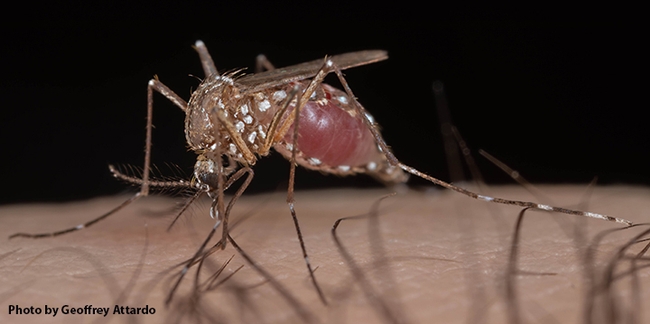
- Author: Kathy Keatley Garvey
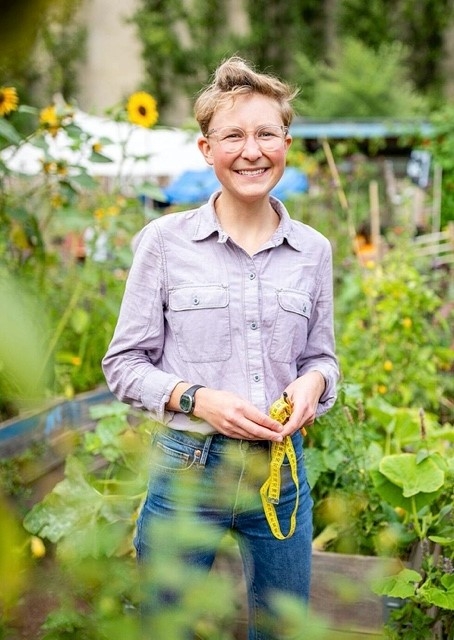
Egerer will speak on "Entomological Investigations in Urban Gardens," focusing on wild bees and natural enemies in urban gardens in Germany, at a virtual seminar hosted by the UC Davis Department of Entomology and Nematology on Wednesday, Nov. 24.
Her seminar begins at 4:10 p.m., Pacific Time. The Zoom link is here.
More than 60 percent of our world's population will live in cities in the next decades, Egerer says in her abstract. "Urban agriculture has great potential to support arthropod biodiversity and thereby potentially enhance ecosystem services such as pollination and pest predation for more sustainable food production. In this talk, I discuss interdisciplinary research on wild bees and natural enemies in urban community gardens in Berlin and Munich, Germany. Specifically, I examine how urban garden management can play an important role in supporting species diversity and the provision of insect-mediated services. Furthermore, I discuss citizen science initiatives that our group uses to engage the public in scientific research on urban biodiversity and ecosystem services."
Egerer, whose research and teaching interests include ecology, biodiversity, agroecology, urban ecology, insect ecology, climate change, and food systems, holds a bachelor's degree in biology (2013) from Kalamazoo College, Mich., and then received her master's degree (2017) and her doctorate (2019) in environmental studies from UC Santa Cruz, studying with major professor Stacy Philpott.
After research work in Australia, Egerer joined the Institute of Ecology at the Technical University of Berlin in 2019 as an International Postdoc Initiative (IPODI) postdoctoral fellow. In 2020, she was appointed to the professorship for Urban Productive Ecosystems in the TUM School of Life Sciences.
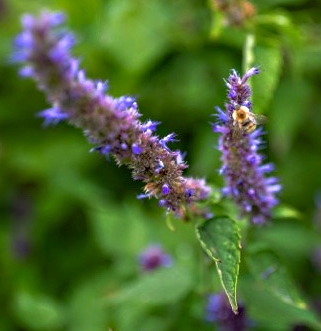
- Egerer M and Kowarik I. (2020) Confronting the modern Gordian Knot of urban beekeeping, Trends in Ecology and Evolution 1-4.
-
Philpott SM, Egerer M, Bichier P, Cohen H, Cohen R, Liere H, Jha S, Lin BB. (2020) Gardener demographics, experience, and motivations drive differences in plant species richness and composition in urban gardens, Ecology and Society
- Buchholz S and Egerer M. (2020) Functional ecology of wild bees in cities: what we know about trait-urbanization relationships, Biodiversity and Conservation 1-23.
-
Philpott SM, Lucatero A, Bichier P, Egerer M, Jha S, Lin BB, Liere H. (2020) Changes in natural enemy-herbivore networks along local and landscape gradients in urban agroecosystems, Ecological Applications 0: 1-13.
-
Egerer M, Lin B, Diekmann L. (2020) Nature connection, experience and policy encourage and maintain adaptation to drought in urban agriculture, Environmental Research Communications 2: 1-12.
-
Egerer M, Liere H, Lucatero A, Philpott SM. (2020) Plant damage in urban agroecosystems varies with local and landscape factors, Ecosphere 11(3): 1-19.
-
Egerer M, Fouch N, Anderson EC, and Clarke M. (2020) Socio-ecological connectivity differs in magnitude and direction across urban landscapes, Scientific Reports 10: 1-16.
- Egerer M, Wagner B, Lin BB, Kendal D and Zhu K. (2020) New methods of spatial analysis in urban gardens inform future vegetation surveying, Landscape Ecology 1: 1-18.
- Egerer M, Cecala JM and Cohen H. (2020) Wild bee conservation within urban gardens and nurseries: effects of local and landscape management, Sustainability 12: 1-10.
The Department of Entomology and Nematology seminars are coordinated by nematologist and assistant professor Shahid Siddique, who may be reached at ssiddique@ucdavis.edu for any technical issues.

- Author: Kathy Keatley Garvey
Let the count begin!
Researchers and volunteers in a three-week project headed by the Xerces Society for Invertebrate Conservation are now counting the Western monarch population at overwintering sites along the California coast.
It all began Saturday. An unofficial count estimates more than 50,000 monarchs are there. That's a huge increase from the fewer than 2000 tally last winter.
An Associated Press story this week indicated that the monarch population is "bouncing back."
Maybe "fluttering back?"
Since the 1980s, the Western monarch population, has declined by more than 99 percent, according to Xerces. That led butterfly expert Art Shapiro, UC Davis distinguished professor of evolution and ecology who has monitored butterfly populations in Central California since 1972, to declare that the Western monarchs are on "life support."
Scientists blame the decline on habitat loss, pesticides and climate change.
How many overwintering sites are there along the California coast? About 100. "One of the best-known wintering places is the Monarch Grove Sanctuary, a city-owned site in the coastal city of Pacific Grove, where last year no monarch butterflies showed up," the Associated Press reported.
"This year a preliminary count showed more than 13,000 monarchs have arrived at the site in Monterey County, clustering together on pine, cypress and eucalyptus trees and sparking hope among the grove's volunteers and visitors that the struggling insects can bounce back."
Monarch scientist David James, a Washington State University entomologist, recently presented a webinar on "Western Monarchs: Migration, Adaptation, Controversies and the Future" for the South West Monarch Study group.
"It was well-received but we had technical problems towards the end," he related on his Facebook page, Monarch Butterflies in the Pacific Northwest. "Gail Morris kindly allowed me to re-record it and you can now find it at the link below. My view of the future of western monarchs is more optimistic than some other monarch researchers. Much of this is based on my research on monarch physiology and ecology conducted 40+ years ago in Sydney, Australia, which showed monarchs well able to adapt to a different environment. I think we are seeing this now in the western US in real time! My thoughts on this are contained within the webinar. The recovery in population numbers at overwintering sites this fall, is not surprising to me but I am surprised at some of the large numbers coming in from various sites. I will take a look at some of the sites over the next few days and will report back here."
See James' presentation on YouTube at https://www.youtube.com/watch?v=g-hh5c8mw6o.
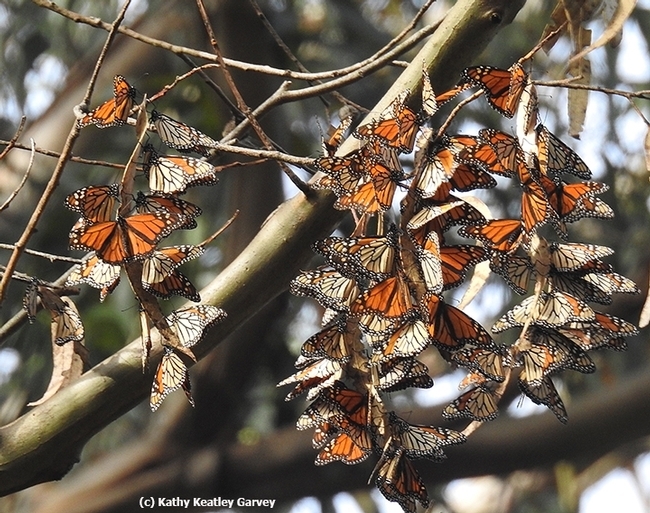
- Author: Kathy Keatley Garvey
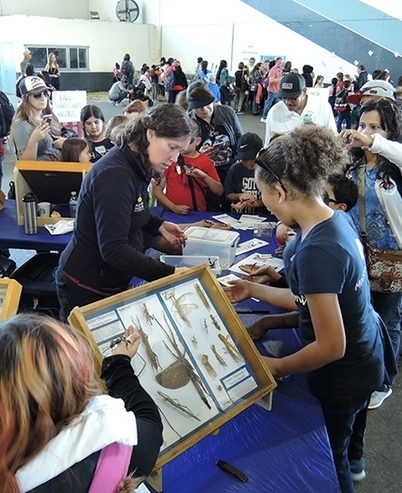
The funds will be used for the student educational projects: creating traveling specimen display boxes to be shown in school classrooms, fairs, festivals, museums, hospitals, libraries, special events and the like, such as 4-H programs.
As they say on their website: "The Bohart Museum of Entomology is a research collection and public museum dedicated to understanding, documenting and communicating terrestrial arthropod diversity. In our 75th year, the Bohart has maintained a robust outreach program that typically connects with over 10,000 people each year. Portable educational boxes have been a great way for us to share the museum experience with others. Housed in the same specimen boxes that we use for the research collection, these displays travel all over Northern California to festivals, events, museums, hospitals and classrooms. UC Davis students, staff, teachers and scout leaders routinely borrow these materials to enrich their programs."
The museum, directed by Lynn Kimsey, UC Davis distinguished professor of entomology, originated in 1946 with two Schmitt boxes of insect specimens collected by noted entomologist Richard M. Bohart (1913-2007), UC Davis professor of entomology and museum founder. Named the Bohart Museum in 1982, it is now the home of nearly eight million insect specimens, collected worldwide.
The Bohart Museum, currently closed to the public due to COVID-19 precautions, is located in Room 1124 of the Academic Surge Building on Crocker Lane, UC Davis campus. In addition to its insect collection, the seventh largest in North America, it houses a live “petting zoo,” comprised of Madagascar hissing cockroaches, stick insects and tarantulas, and a gift shop (now online), stocked with insect-themed t-shirts, hoodies, jewelry, books, posters and other items. Further information is on the website at https://bohart.ucdavis.edu.
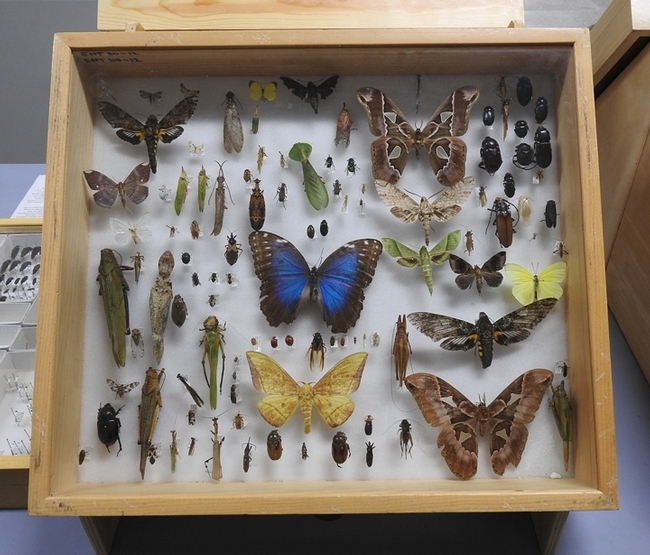
- Attardo Family
- Dustin Blakey
- In Honor of Lynn Kimsey from Jason and Kristen Bond
- In Honor of Lynn Kimsey from Bonnie Bradt
- Bjorn Bush
- Joanna Chiu
- Molly Ferrell
- Glen Forister
- In Honor of Tabatha Yang from Elaine Gibson
- In Honor of Lynn Kimsey from Jessica Gillung
- In Memory of Robbin W. Thorp from James Matthew Gonzales-Harris
- Tiki Harlow
- Timotheus Itoi
- In Memory of Nick Booster from Hanna Kahl
- In Memory of Robbin Thorp, (1933-2019) UC Davis distinguished emeritus professor of entomology from Kathy Keatley Garvey
- In Memory of Richard M. Bohart from Lynn Kimsey
- Stephanie Kurniawan
- In Memory of Michel MJ Lavoipierre from his children Frédérique, Xavier, and Philippe Lavoipierre
- Pam Marrone and Mick Rogers
- Gwyneth Morris
- Eric Mussen
- Michelle Posey
- Oliver Ramsey
- Linda Rosenfield and Arnold Menke
- Nancie Ryan
- Heather Sabin
- Luana Staiger
- James Starrett
- In Honor of Tabatha Yang from Ralph Washington Jr.
- Nancy Williams
- Valerie Williamson
- Karey Windbiel-Rojas
- In Honor of Kathy Keatley Garvey and her Bug Squad Blog from an Anonymous Donor
- In Honor of Earth's Flora and Fauna from an Anonymous Donor
- In Honor of Tabatha Yang from an Anonymous Donor
- And all other Anonymous Donors
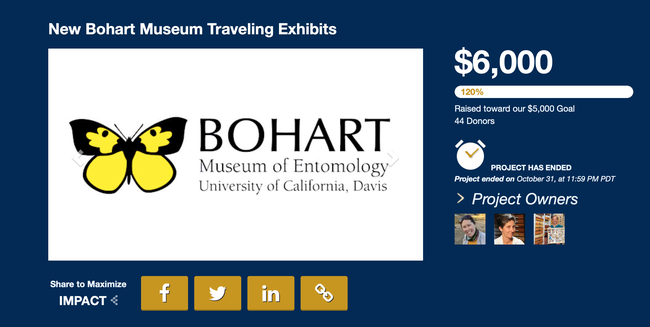
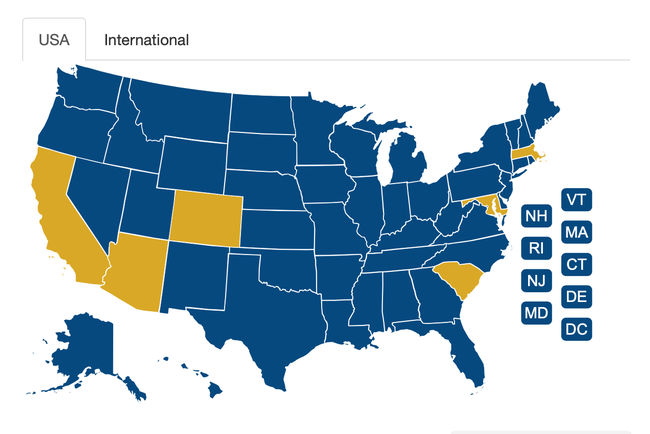
- Author: Kathy Keatley Garvey

So what do entomology professors collect?
Well, if your name is Lynn Kimsey, director of the Bohart Museum of Entomology and a distinguished professor of entomology at the University of California, Davis, you collect both insects--AND sentences from students' term papers that show what she calls "the taxonomic and biological fails."
First, let's briefly introduce Professor Kimsey. An alumnus of UC Davis, she received her undergraduate degree in 1975 and doctorate in 1979. She joined the UC Davis faculty in 1989. A two-term president of the International Hymenopterists, and a recognized global authority on the systematics, biogeography and biology of the wasp families, Tiphiidae and Chrysididae, she won the 2020 C. W. Woodworth Award, the highest award given by the Pacific Branch of the Entomological Society of America, for "her 31 years of outstanding accomplishments in research, teaching, education, outreach and public service."
Her home away from home is the Bohart Museum, which houses a worldwide collection of nearly 8 million insect specimens. The insect museum is now located in Room 1124 of the Academic Surge Building on Crocker Lane, UC Davis campus. Note that it's currently closed to the public due to COVID-19 pandemic precautions, but the work continues.
So does the sentence collection.
Let's blame it on the students' inadequate consumption of coffee, shall we? Or too little time and too much anxiety?
Anyway, Kimsey's treasured-sentence collection over the past two decades resulted in her publication of "Entomological Musings in the Classroom" in the June 7, 2019 edition of American Entomologist.
"One of the outcomes of teaching a general entomology course to undergraduates for many, many years is that I have taken on a new appreciation for science fiction and fantasy," Kimsey wrote. "This happens, in part, because every year, a student makes some new scientific discovery about an insect that causes me to slap my forehead and say 'They do what!?' The other part is how little students (or the public in general) know about insects, in contrast to how much they think they know. Most of my students are not entomology majors, and many aren't even majors in the biological sciences, so there are a lot of misconceptions. Nonetheless, there is huge entertainment in enlightenment.
"One aspect of teaching this course (General Entomology) that is less entertaining is the writing requirement," Kimsey continued. "Students at the University of California, Davis, are required to take a number of units in general education science and writing. My course fulfills two of those requirements, which means that I have to require (and grade) student term papers as part of their assignments. I can say definitively that student writing abilities have not improved over the years. So, to alleviate the pain of grading these works of art, I started collecting particularly silly or otherwise awesome sentences from their papers."
So, let's update the sentence collection, shall we? Here are some of her recent favorites:
- "The palpalis (a species group of Glossina) can be found near water like a stream or rainforest where they feed mainly on reptiles although they can also adapt to eat similar animals as Glossina morsitian."
- "The Aedes and Culex genuses of mosquitoes are the most frequently related species to arbovirus transmission, with the Culicoides and Lasiohelea genuses of ticks also remaining a common vector."
- "The vast net casted by species infected with arbovirus means that a lot of people and animals are potential homes for infected insects to transfer the virus to."
- "Their species characteristics are valuable to themselves, plants, animals, and humans."
- "As eggs, they have a thick membrane encasing and this helps the egg attach to the female Cuterebridae."
- "The arbovirus has its roots in the tropically-located regions of Earth, and therefore thrives in humid, sunny environments."
- "They (dragonflies) emerged roughly 325 MYA and have dominated the insect world with their superior haunting skills and complex flight mechanism, and senses."
However, some of my all-time favorites that Professor Kimsey included in her American Entomologist article are:
-
"Honeybees were able to find their way home by navigating around the sun."
- "Because the males in the Hymenoptera social structure do no work, they are considered a waste of the colony's energy, and as such, they are only laid when the colony can stand the strain."
- "Unlike worker bees, drones do not have a stinger in hand."
Sigh. Collective sigh.
